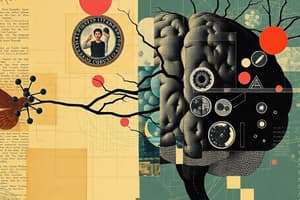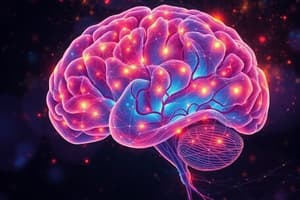Podcast
Questions and Answers
What is programmed cell death?
What is programmed cell death?
Process where excess neurons are eliminated to improve brain efficiency due to brain over-producing neurons during prenatal and postnatal development.
What is synaptic pruning?
What is synaptic pruning?
Selective removal of weaker or unused synaptic connections to refine neural networks and improve brain efficiency.
What is plasticity?
What is plasticity?
Brain's ability to change and reorganize in response to experiences.
What is high plasticity in infancy?
What is high plasticity in infancy?
What are limits of plasticity?
What are limits of plasticity?
What are sensitive periods of brain development?
What are sensitive periods of brain development?
What sensitive periods occur during infancy and toddler hood?
What sensitive periods occur during infancy and toddler hood?
What are language sensitive periods?
What are language sensitive periods?
What are vision sensitive periods?
What are vision sensitive periods?
What are emotional attachment sensitive periods?
What are emotional attachment sensitive periods?
What in sensitive periods are vital for brain growth?
What in sensitive periods are vital for brain growth?
What is experience-expectant growth?
What is experience-expectant growth?
What type of experience growth would see, hearing, language, and touching objects be?
What type of experience growth would see, hearing, language, and touching objects be?
What type of experience growth would learning multiple languages and learning an instrument be?
What type of experience growth would learning multiple languages and learning an instrument be?
What skills have no sensitive periods in first 6 years of life?
What skills have no sensitive periods in first 6 years of life?
What are skills that depend on extensive training?
What are skills that depend on extensive training?
What can overstimulation through parents or early-learning centers lead to?
What can overstimulation through parents or early-learning centers lead to?
How do infants learn best?
How do infants learn best?
What are the three principles of early brain development?
What are the three principles of early brain development?
What is the brain growth principle of early brain development?
What is the brain growth principle of early brain development?
When is the brain about 75% of its adult weight?
When is the brain about 75% of its adult weight?
What is the myelination principle of early brain development?
What is the myelination principle of early brain development?
What is the plasticity and adaptability principle of early brain development?
What is the plasticity and adaptability principle of early brain development?
What are growth trends in the body?
What are growth trends in the body?
What is cephalocaudal development?
What is cephalocaudal development?
What is proximodistal development?
What is proximodistal development?
What growth trend is focused on holding up head, rolling and sitting?
What growth trend is focused on holding up head, rolling and sitting?
What growth trend is focused on balance and body turning?
What growth trend is focused on balance and body turning?
Flashcards
What is programmed cell death?
What is programmed cell death?
Process where excess neurons are eliminated to improve brain efficiency during prenatal and postnatal development.
What is synaptic pruning?
What is synaptic pruning?
Selective removal of weaker or unused synaptic connections to refine neural networks and improve brain efficiency.
What is plasticity?
What is plasticity?
Brain's ability to change and reorganize in response to experiences.
What is high plasticity in infancy?
What is high plasticity in infancy?
Signup and view all the flashcards
What are limits of plasticity?
What are limits of plasticity?
Signup and view all the flashcards
What are sensitive periods of brain development?
What are sensitive periods of brain development?
Signup and view all the flashcards
What sensitive periods occur during infancy and toddler hood?
What sensitive periods occur during infancy and toddler hood?
Signup and view all the flashcards
What are language sensitive periods?
What are language sensitive periods?
Signup and view all the flashcards
What are vision sensitive periods?
What are vision sensitive periods?
Signup and view all the flashcards
What are emotional attachment sensitive periods?
What are emotional attachment sensitive periods?
Signup and view all the flashcards
Study Notes
- Programmed cell death involves eliminating excess neurons to improve brain efficiency.
- This occurs due to brain overproduction during prenatal and postnatal development.
- Synaptic pruning is the selective removal of weaker or unused synaptic connections.
- It refines neural networks and improves brain efficiency.
- Plasticity is the brain's ability to change and reorganize in response to experiences.
- High plasticity in infancy means that if one part of the brain is damaged, other areas can take over its functions.
- Brain plasticity decreases with age, making later learning and recovery more challenging.
- Sensitive periods of brain development are times during early development when the brain is especially responsive to specific experiences.
- Sensitive periods during infancy and toddlerhood include language, vision, motor skills, and emotional attachment.
- Language sensitive periods indicate that infants need early exposure to speech.
- If they dont get it, they may struggle to fully develop language later.
- During vision sensitive periods infants may have permanently impaired vision if eye problems are not treated early.
- Emotional attachment sensitive periods indicate that strong caregiver bonds in infancy shape emotional regulation skills later in life.
- Appropriate stimulation is vital for brain growth during sensitive periods.
- Experience-expectant growth is brain growth that occurs early and naturally.
- It depends on ordinary experiences and sensitive periods.
- Experience-dependent growth is additional brain growth that occurs throughout life, resulting from specific learning experiences.
- It does not depend on sensitive periods.
- Seeing, hearing, language, and touching objects are examples of experience-expectant growth.
- Learning multiple languages and learning an instrument are examples of experience-dependent growth.
- Skills that depend on extensive training have no sensitive periods in the first 6 years of life.
- Reading, music, art, and sports are skills that depend on extensive training.
- Overstimulation through parents or early-learning centers can lead to withdrawal, lack of desire to learn, and disappointed parents.
- Infants learn best through interaction, exploration, and play.
- The three principles of early brain development are brain growth, myelination, plasticity, and adaptability.
- The brain grows rapidly in infancy, with most neurons forming before birth but continuing to make new connections.
- The brain is about 75% of its adult weight by age 2.
- Myelination is the process where neurons are insulated with myelin, which speeds up brain processing.
- Plasticity and adaptability mean the brain adapts based on experience, but unused pathways weaken over time.
- Growth trends in the body include cephalocaudal and proximodistal development.
- Cephalocaudal development is head-to-tail growth.
- Growth occurs from the head downward and the head develops more rapidly than other parts of the body.
- Proximodistal development is near-to-far growth.
- Growth occurs from the center of the body outward, where proximal parts develop more rapidly than distal parts.
- Holding up the head, rolling, and sitting are focused on cephalocaudal development.
- Balance and body turning are focused on proximodistal development.
Studying That Suits You
Use AI to generate personalized quizzes and flashcards to suit your learning preferences.




